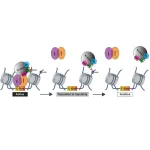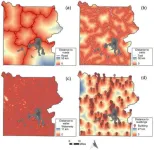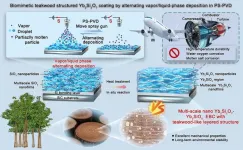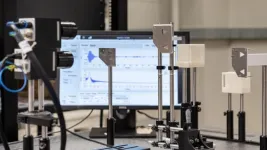(Press-News.org) A new study has unravelled the hidden mechanics of how earthquakes ignite, shedding light on the mysterious transition from quiet, creeping motion to the violent ruptures that shake the Earth. Using cutting-edge experiments and innovative models, the research reveals that slow, silent stress release is a prelude and a necessary trigger for seismic activity. By incorporating the overlooked role of fault geometry, the study challenges long-held beliefs and offers a fresh perspective on how and when earthquakes begin. These findings not only deepen our understanding of nature’s most powerful forces but also pave the way for improved predictions of seismic events.
Researchers from the Racah Institute of Physics at the Hebrew University of Jerusalem, led by Prof. Jay Fineberg and PhD. Student Shahar Gvirtzman in collaboration with Prof. David S. Kammer from ETH Zurich and Prof. Mokhtar Adda-Bedia from École Normale Supérieure de Lyon, have unveiled groundbreaking insights into the mechanisms driving frictional rupture and earthquake nucleation. Their study bridges critical gaps in our understanding of the transition from slow, aseismic motion to rapid seismic rupture.
The team conducted experiments and developed theoretical models to demonstrate how slow, steady creep at stress thresholds transitions into the dynamic rupture associated with earthquakes. By extending the principles of fracture mechanics, the researchers incorporated the finite width of fault interfaces, a factor often overlooked in traditional models.
"Our findings challenge and refine conventional models of rupture dynamics," explained Prof. Fineberg. "We show that slow, aseismic processes are a prerequisite for seismic rupture, driven by localized stress and geometric constraints. This has profound implications for understanding when and how earthquakes begin."
Key highlights of the study include groundbreaking experimental validation, where the researchers employed high-speed imaging and innovative methodologies to observe how rupture nucleation begins. Their findings reveal that the process initiates as small, slow-moving two-dimensional patches of frictional motion. These patches gradually expand and eventually transition into the rapid dynamics traditionally described by classical fracture mechanics, marking a significant leap in our understanding of this phenomenon.
The study also emphasizes the critical role of geometric transitions in controlling nucleation dynamics. By incorporating the finite width of fault interfaces into their models, the researchers challenged and refined existing theories of earthquake initiation. This focus on the geometric properties of faults provides fresh insights into the structural and mechanical factors that influence the onset of seismic activity.
Furthermore, the research has far-reaching real-world applications. The newly developed framework also offers a deeper understanding of important everyday processes of both friction and material fracture. In addition, the new framework underscores the importance of slow, aseismic processes that often precede earthquakes. Even seemingly 'quiet' seismic precursors, which might previously have been overlooked, could hold critical information about impending seismic events. This discovery has the potential to inform predictive models and improve our ability to anticipate and mitigate earthquake risks.
The study's implications extend beyond earthquake science, offering insights into material strength, fracture dynamics, and the development of predictive models for seismic activity.
END
The hidden mechanics of earthquake ignition
2025-01-08
ELSE PRESS RELEASES FROM THIS DATE:
Scientists leverage artificial intelligence to fast-track methane mitigation strategies in animal agriculture
2025-01-08
BUSHLAND, Texas, Jan. 8, 2025 –A new study from USDA’s Agricultural Research Service (ARS) and Iowa State University (ISU) reveals that generative Artificial Intelligence (AI) can help expedite the search for solutions to reduce enteric methane emissions caused by cows in animal agriculture, which accounts for about 33 percent of U.S. agriculture and 3 percent of total U.S. greenhouse gas emissions.
"Developing solutions to address methane emissions from animal agriculture is a critical priority. Our scientists continue to use innovative and data-driven strategies to help ...
Researchers unravel a novel mechanism regulating gene expression in the brain that could guide solutions to circadian and other disorders
2025-01-08
A collaborative effort between Mount Sinai and Memorial Sloan Kettering Cancer Center has shed valuable light on how monoamine neurotransmitters such as serotonin, dopamine, and now histamine help regulate brain physiology and behavior through chemical bonding of these monoamines to histone proteins, the core DNA-packaging proteins of our cells.
By uncovering how these histone modifications influence the brain, the team has identified a novel mechanism for controlling circadian gene expression and behavioral rhythms. ...
Discovery of 'Punk' and 'Emo' fossils challenges our understanding of ancient molluscs
2025-01-08
Researchers have unearthed two fossils, named Punk and Emo, revealing that ancient molluscs were more complex and adaptable than previously known.
Molluscs are one of life’s most diverse animal groups and analysis of the rare 430 million year old fossils is challenging long-held views on their early origins.
The fossils dating from the Silurian period were retrieved from Herefordshire and shed light on the molluscs’ complex evolutionary history and how they moved.
The discovery challenges the longstanding ...
Exposure to aircraft noise linked to worse heart function
2025-01-08
People who live close to airports and are exposed to high aircraft noise levels could be at greater risk of poor heart function, increasing the likelihood of heart attacks, life-threatening heart rhythms and strokes, according to a new study led by UCL (University College London) researchers.
The study, published in the Journal of the American College of Cardiology (JACC), looked at detailed heart imaging data from 3,635 people who lived close to four major airports in England.
Within this group, the research team compared the hearts of those who lived in areas with higher aircraft noise with those who lived in lower aircraft noise areas.
They found that those who lived in ...
Deans of the University of Nottingham visited Korea University's College of Medicine
2025-01-08
Deans of the University of Nottingham Visited Korea University's College of Medicine
Korea University's College of Medicine Dean, Sung Bom Pyun, and Deans of the University of Nottingham; successfully held a researcher meeting program for 2 days from November 11th to 12th.
Fuve representative deans visited the University of Korea: Professor Claire Stewart, the Dean and Head of the School of Medicine at the University of Nottingham; Professor Nigel Mongan, Professor Alan McIntyre, Professor Srinivasan Madhusudan, and Professor Victoria James. They joined the program to conduct a tour and meeting with Korea University's researchers.
On ...
New study assesses wildfire risk from standing dead trees in Yellowstone National Park
2025-01-08
Standing dead trees in Yellowstone National Park are growing wildfire hazards, especially near park infrastructure. A new study published in Forest Ecosystems explores how these dead trees contribute to fire risk and threaten roads, buildings, and trails.
Dead trees, particularly those that remain standing, are a significant fire hazard. These trees—often caused by pests, diseases, and climate change—create a large amount of dry, combustible material. As temperatures rise and droughts intensify, the risk of wildfires increases, making it essential to understand how dead trees contribute to fire danger.
The team used a random forest classification model, a powerful ...
A new approach for improving hot corrosion resistance and anti-oxidation performance in silicide coating on niobium alloys
2025-01-08
The widely used nickel-based superalloys for turbine engine materials showed a limited-service temperature of only 1200℃, and did not exceed 1500℃ even when coated with thermal barrier coatings, which is urgent to develop the advanced thermal protection system for turbine engines with higher thrust-weight ratios. Niobium alloy coated with silicide coating is undoubtedly considered the most efficient method to reach long-term service, since it can form a dense SiO2 layer with self-healing ability at high temperatures. However, the single silicide coating has a strong tendency to crack vertically ...
UC San Diego to lead data hub of CDC-funded pandemic preparedness network
2025-01-08
The Centers for Disease Control and Prevention (CDC) has selected University of California San Diego as one of three partner institutions to establish a groundbreaking pandemic preparedness initiative, the Community and Household Acute Respiratory Illness Monitoring (CHARM) Network. The new five-year cooperative agreement will help generate information on how respiratory viruses spread and provide insights into factors impacting susceptibility to respiratory illnesses. At UC San Diego, the cooperative agreement supports the $5.7 million project, “PREVENT: Preparedness through Respiratory Virus Epidemiology and Community Engagement” led by Louise Laurent, M.D., Ph.D., ...
Biomimetic teakwood structured environmental barrier coating
2025-01-08
The core message of the article is that researchers have developed an innovative technology in plasma spraying-physical vapor deposition known as alternating vapor/liquid phase deposition. By adjusting the arc current, researchers can finely control the evaporation and deposition of SiO2, and through a heat treatment process, achieve in-situ reactions that optimize the composition, structure, and nanoscale dimensions of the coating, creating an orderly arranged multi-layered teak-like biomimetic structure within it. They have conducted an in-depth analysis of the complex deposition mechanisms involved in this process. This new teak-like biomimetic structure coating is expected ...
Low-cost system will improve communications among industrial machines
2025-01-08
Researchers have found a low-power, inexpensive way for large numbers of devices, such as machines in factories and equipment in labs, to share information by efficiently using signals at untapped high frequencies.
The technology could immediately enable low-cost, efficient real-time monitoring in industrial settings, such as tracking the condition of manufacturing robots or detecting gas leaks in refineries, by eliminating the need for power-hungry signal transmitters. The researchers said that with some engineering improvements, the technology ...





